This article has multiple issues. Please help improve it or discuss these issues on the talk page . (Learn how and when to remove these messages)
|
The United States has several coins and banknotes which were proposed at one time but never adopted.
This article has multiple issues. Please help improve it or discuss these issues on the talk page . (Learn how and when to remove these messages)
|
The United States has several coins and banknotes which were proposed at one time but never adopted.
A three dollar bill was proposed two times during the 1860s. A design was engraved for a potential $3 United States Note, and a 1865 law called for a $3 National Bank Note, but neither proposal came to fruition.[ citation needed ]
| Denomination | Obverse | Reverse | Notes |
|---|---|---|---|
| $3 note | 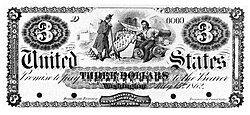 | 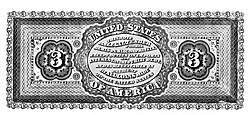 | Not to be confused with fake or privately issued obsolete notes or the three-dollar Continental currency banknotes issued during the American Revolution |
There have been several United States coins which were proposed but never adopted. Most of the coins listed below, although never adopted, were produced in limited numbers as patterns.
| Denomination | Obverse | Reverse | Weight | Diameter | Material | Edge | Minted | Notes |
|---|---|---|---|---|---|---|---|---|
| Silver center cent 1¢ |  |  | 4.48 g | 24.00 mm | Cu (ring) Ag (plug) | reeded | 1792 | The first and only US bi-metallic coin until the 2000 Library of Congress ten dollar coin. |
| Ring cent 1¢ |  |  | various weights | 90% Cu 10% Ag [lower-alpha 1] | various | 1850–1851, 1853 [lower-alpha 2] , 1884–1885 | 196 ring cents (originals and restrikes) are known to exist. [1] Examples exist with or without a hole. | |
| Aluminum cent 1¢ |  |  | 0.937 g | 19.05 mm | 96% Al 4% trace metals | plain | 1973–1975 | 1,579,324 coins dated 1974 were produced, but were not put in circulation and nearly all were later destroyed. [2] |
| Two-cent billon 2¢ |  |  | 3.84 g | ~13.00 mm | 90% Cu 10% Ag | plain | 1836 | [3] |
| Two and a half cent piece 2.5¢ | unknown | unknown | unknown | unknown | never minted | Proposed in 1916 by US mint director Robert W. Woolley. [4] Civil War tokens of this denomination exist. | ||
| Three-cent bronze 3¢ |  |  | 10.89 g | 28.57 mm | 95% Cu 5% Zn | plain | 1863 | |
| Ring nickel 5¢ |  |  | plain | 1884–1885 | [5] [6] | |||
| Gold ring half dollar 50¢ |  |  | 1852 | [7] | ||||
| Gold ring dollar $1 |  |  | 1849, 1852 | [8] [9] | ||||
| Two dollar piece $2 | unknown | unknown | unknown | unknown | never minted | Proposed but not minted. [10] Some privately struck renditions exist. [11] | ||
| Stella $4 |  |  | 7.00 g | 22 mm | 6.00g Au 0.30g Ag 0.70g Cu | reeded | 1879–1880 | [12] |
| Half-union $50 |  |  | 83.58 g | 50.80 mm | 90% Au 10% Cu [lower-alpha 3] | reeded | 1877 | Commemorative coins of this denomination were issued in 1915. [14] Several bullion coins are produced in this denomination. |
| Union $100 |  |  | unknown | unknown | 90% Au 10% Cu | unknown | never minted | Canceled before any patterns could be minted (fantasy coin shown). Some commemorative and bullion coins are minted in this denomination. |

1943 steel cents are U.S. one-cent coins that were struck in steel due to wartime shortages of copper. The Philadelphia, Denver, and San Francisco mints each produced these 1943 Lincoln cents. The unique composition of the coin has led to various nicknames, such as wartime cent, steel war penny, zinc cent and steelie. The 1943 steel cent features the same Victor David Brenner design for the Lincoln cent which had been in use since 1909.

A nickel is a five-cent coin struck by the United States Mint. Composed of cupronickel, the piece has been issued since 1866. Its diameter is 0.835 inches (21.21 mm) and its thickness is 0.077 inches (1.95 mm).

The two-cent piece was produced by the Mint of the United States for circulation from 1864 to 1872 and for collectors in 1873. Designed by James B. Longacre, there were decreasing mintages each year, as other minor coins such as the nickel proved more popular. It was abolished by the Mint Act of 1873.

A double eagle is a gold coin of the United States with a denomination of $20. The coins are 34 mm × 2 mm and are made from a 90% gold and 10% copper alloy and have a total weight of 1.0750 troy ounces.

The Liberty Head nickel, sometimes referred to as the V nickel because of its reverse design, is an American five-cent piece. It was struck for circulation from 1883 until 1912, with at least five pieces being surreptitiously struck dated 1913. The obverse features a left-facing image of the goddess of Liberty.

The American twenty-cent piece is a coin struck from 1875 to 1878, but only for collectors in the final two years. Proposed by Nevada Senator John P. Jones, it proved a failure due to confusion with the quarter, to which it was close in both size and value.

A pattern coin is a coin which has not been approved for release, but produced to evaluate a proposed coin design. They are often off-metal strike, to proof standard or piedforts. Many coin collectors collect and study pattern coins because of their historical importance. Many of the world's most valuable coins are pattern coins; nearly 25 of the pieces listed in 100 Greatest US Coins are pattern coins.

The Indian Head cent, also known as an Indian Head penny, was a one-cent coin ($0.01) produced by the United States Bureau of the Mint from 1859 to 1909. It was designed by James Barton Longacre, the Chief Engraver at the Philadelphia Mint.
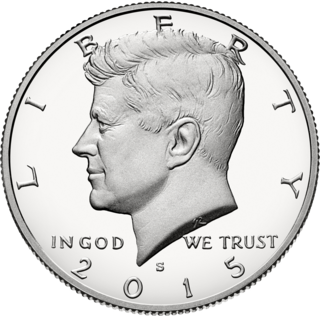
The Kennedy half dollar, first minted in 1964, is a fifty-cent coin issued by the United States Mint. Intended as a memorial to the assassinated 35th president of the United States John F. Kennedy, it was authorized by Congress just over a month after his death. Use of existing works by Mint sculptors Gilroy Roberts and Frank Gasparro allowed dies to be prepared quickly, and striking of the new coins began in January 1964.

The United States large cent was a coin with a face value of 1/100 of a United States dollar. Its nominal diameter was 11⁄8 inch (28.57 mm). The first official mintage of the large cent was in 1793, and its production continued until 1857, when it was officially replaced by the modern-size one-cent coin.

The Flying Eagle cent is a one-cent piece struck by the Mint of the United States as a pattern coin in 1856 and for circulation in 1857 and 1858. The coin was designed by Mint Chief Engraver James B. Longacre, with the eagle in flight based on the work of Longacre's predecessor, Christian Gobrecht.

The gold dollar or gold one-dollar piece is a gold coin that was struck as a regular issue by the United States Bureau of the Mint from 1849 to 1889. The coin had three types over its lifetime, all designed by Mint Chief Engraver James B. Longacre. The Type 1 issue has the smallest diameter of any United States coin minted to date.

The 1974 aluminum cent was a one-cent coin proposed by the United States Mint in 1973. It was composed of an alloy of aluminum and trace metals, and it was intended to replace the predominantly copper–zinc cent due to the rising costs of coin production in the traditional bronze alloy. Of the 1,571,167 coins struck in anticipation of release, none were released into circulation. To encourage congressional support for the new alloy, the Mint distributed several examples to U.S. Congressmen. When the proposed aluminum cent was rejected, the Mint recalled and destroyed those coins.
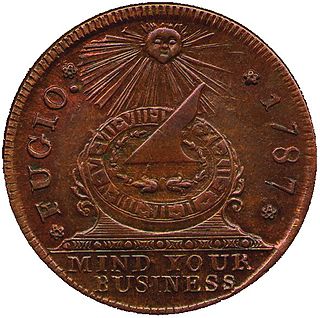
The Fugio cent, also known as the Franklin cent, is the first official circulation coin of the United States. Consisting of 0.36 oz (10 g) of copper and minted dated 1787, by some accounts it was designed by Benjamin Franklin. Its design is very similar to Franklin's 1776 Continental Currency dollar coin that was produced in pattern pieces as potential Continental currency but was never circulated.

The Coronet large cent was a type of large cent issued by the United States Mint at the Philadelphia Mint from 1816 until 1857.
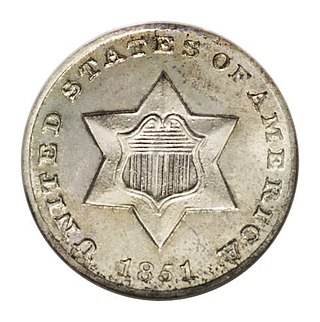
The three-cent silver, also known as the three-cent piece in silver or trime, was struck by the Mint of the United States for circulation from 1851 to 1872, and as a proof coin in 1873. Designed by the Mint's chief engraver, James B. Longacre, it circulated well while other silver coinage was being hoarded and melted, but once that problem was addressed, became less used. It was abolished by Congress with the Coinage Act of 1873.

The Susan B. Anthony dollar is a United States dollar coin minted from 1979 to 1981, when production was suspended due to poor public acceptance, and then again in 1999. Intended as a replacement for the larger Eisenhower dollar, the new smaller one-dollar coin went through testing of several shapes and compositions, but all were opposed by the vending machine industry, a powerful lobby affecting coin legislation. Finally, a round planchet with an eleven-sided inner border was chosen for the smaller dollar.

The ring cent or holey cent was a one-cent pattern coin first struck in various compositions and designs between 1850 and 1851 as part of an experiment on producing a cent with a reduced weight and diameter, as the rising price of copper had caused cents to cost more than their face value to produce. Many varieties exist, with differing designs as well as differing compositions, including billon (standard), aluminum, copper, cupronickel, nickel silver, nickel, silver, and white metal.

The 1942 experimental cents were pattern coins struck by the United States Mint to test alternative compositions for the penny.

The Washington nickel is a pattern coin that was struck by the United States Mint in 1866 and again in 1909 and 1910.